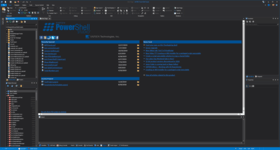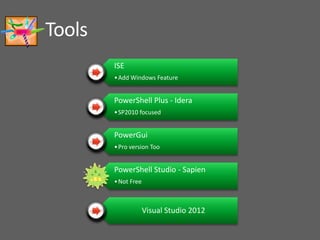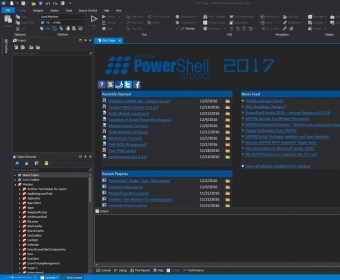

- #SAPIEN POWERSHELL STUDIO REVIEW FULL#
- #SAPIEN POWERSHELL STUDIO REVIEW CODE#
- #SAPIEN POWERSHELL STUDIO REVIEW WINDOWS#

Distributing files with your packaged scripts.Displaying Help for a Script in an Executable File.PowerShell Studio: Knowing when to use STA mode.Handling Progress with a Background Job in a GUI Application.PowerShell Studio: Passing and Returning Values using Forms.PowerShell Studio: OnApplicationLoad Function.PowerShell Studio: Initializing my GUI controls.PowerShell Studio: Enable and Disable Groups of Controls.PowerShell GUI Debugging Tip: Duplicate Event Handlers.PowerShell GUI Apps: Why think in events?.Closing the Form: What you might expect and what really happens.Adding auto-complete to an input textbox.User interface design for administrators.A Branded Image for a PowerShell GUI App.I see a gray form and I want it painted black!.PowerShell Studio: Creating Responsive Forms.PowerShell Debugging: You can change variables but don’t shoot yourself in the foot!.PrimalScript: VBScript gets a debug console.PrimalScript: PowerShell Debugger enhancements.PowerShell V2 Bug Introduced After Installing V3.Debugging PowerShell modules with PrimalScript.Debugging multiple scripts with PrimalScript.You need JavaScript enabled to view it. and follow her on Twitter at Prev You can reach her at This email address is being protected from spambots. June Blender is a technology evangelist at SAPIEN Technologies, Inc. The moral of the story is that it takes an hour to watch a PowerShell Summit presentation, but the inspiration might save you days of work.
#SAPIEN POWERSHELL STUDIO REVIEW WINDOWS#
Now, it’s available to me in every Windows PowerShell session that uses my profile. The only glitch is that dynamic type data is specific to a session, so I saved the Update-TypeData command in my Windows PowerShell profile.

PS C:\> $hashback = Invoke-Expression ( Get-Content -Raw. Value Īnd, convert it back to a hash table. The only change I made was to replace the $hash parameter value with $this, which indicates the instances of the HashTable class. The Value is the content of my little function. And, I want to override the current (not very helpful) ToString() method, so I set the MemberName parameter value to ToString. It’s a script for a method, so I used the ScriptMethod member type.
#SAPIEN POWERSHELL STUDIO REVIEW FULL#
I set the value of the TypeName parameter to the full name of the hash table type,.

(You can also read about it in the help topic for Update-TypeData, but Bartek is more fun to watch.) So, I used the Update-TypeData trick that Bartek explains so nicely.
#SAPIEN POWERSHELL STUDIO REVIEW CODE#
I want this code to run when I call the ToString() method of a hash table. (Hint: I used PowerRegEx in the SAPIEN Productivity Pack to find that “\s”.) function Convert-HashToString The only tricky part was using escape characters to preserve quotation marks when the key includes a special character. It just builds a string that conforms to the hash table syntax for Windows PowerShell. I wrote a little function that converts any hash table to a string. The obvious solution is the ToString() method of hash tables, but that just returns the type. So, the only piece that was missing was saving a hash table as a string in a file. Invoke-Expression ( Get-Content –Raw -Path ( Get-Module –List BranchCache).Path)ī1xml PS C:\> $manifest And, you can get the values of keys in the manifest hash table, such as FormatsToProcess, either by using a dot to get the property or by using conventional hash table syntax. If you get the content of that hash table… Get-Content ( Get-Module –List BranchCache).Pathīut if you use Invoke-Expression and the Raw parameter of Get-Content, you get a hash table. If you open them in Notepad, they look like this: (Some nice folks on Twitter have reported that this technique does not work on files with digital signatures.) $result = Invoke-Expression ( Get-Content –Raw –Path )įor example, the module manifest files in Windows PowerShell contain a hash table string. Use the Invoke-Expression cmdlet and the Raw parameter of the Get-Content cmdlet. It’s easy to create a hash table in Windows PowerShell: = "Fred" ID = "3" }Īnd, beginning in Windows PowerShell 3.0, it’s easy to get a hash table string from a file and convert it to a hash table object. After watching Windows PowerShell MVP Bartek Bielawski’s excellent presentation, in which he reviews PSCustomObjects and dynamic type data, I was inspired to fix a shortcoming in the. I didn’t make it to the PowerShell Summit 2014 in Europe this year, but I’ve been getting much of the benefit by watching the Summit presentations on YouTube.


 0 kommentar(er)
0 kommentar(er)
